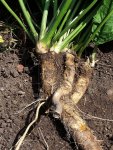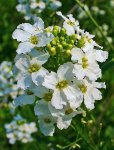Common horseradish - armoracia rusticana
Family Cabbage (Brassicaceae).
Botanical characteristics. Perennial herb with a thick fleshy root. Stem erect, 60 - 120 cm tall, branched at the top, hollow, furrowed. Basal leaves are large, oblong-oval, dentate. Lower cauline leaves pinnately divided, median - oblong-lanceolate, upper - linear, almost linear, entire-edge. Flowers are bisexual, regular, in many-flowered brushes, white petals. Blooms in May - June. Fetus is an elongated bloated pod.
Spread. In the wild, horseradish is found everywhere in European territory, in the Caucasus, in Siberia.
Chemical composition. Roots of horseradish contain vitamins B, PP, ascorbic acid, carbohydrates (sucrose, pentosan, galactose, arbinose, xylose), polysaccharides, galacturonic acid, glycosides, saponins, mustard oil, mineral salts of nitrogen, potassium, calcium, magnesium, iron, copper , As well as phosphorus, sulfur, and chlorine. Horseradish leaves are rich in vitamins of group B, C, PP, and also with mineral salts.
Used parts of the plant. For medicinal purposes, fresh roots of horseradish, leaves are harvested. The roots are excavated in autumn and kept in wet sand in the cellar.
Application of horseradish in medicine
The plant has a high amount of phytoncids, also a bactericidal substance, lysozyme, which makes horseradish an indispensable anti-inflammatory agent.
In folk medicine horseradish is used to enhance the immunological properties of the body, used to treat hypovitaminosis, scurvy, to improve digestion, stimulation of appetite. It is known as an expectorant and diuretic. Juice diluted with water (1: 1), rinse the mouth with stomatitis, periodontal disease, gingivitis, angina, laryngitis.
Grated horseradish is used as a mustard for muscles and joints. Fresh compresses are applied from fresh leaves with radiculitis, sciatica, neuralgia.
Horseradish increases its activity during overfatigue, physical exhaustion, anemia, headache, high blood pressure.
Horseradish mixed with kefir , is useful in diabetes, cancer. Grated horseradish with honey in folk medicine is used for tuberculosis, bronchitis, bronchial asthma, hepatitis, Botkin's disease.
Fresh horseradish juice is treated with nasal baldness, compresses are made from it for pustular lesions of the skin, for pigment spots, masks for fading skin.
Preparation
- Infusion of roots of horse radish ordinary: Dessert spoon of the crushed roots is poured with 1 glass of boiled water and insist 1 hour, filter. Take 2 tbsp. L. 3 times a day with a decrease in appetite, sluggish digestion, anemia.
- Horseradish juice with yogurt: 1 tbsp. L. Juice mixed with a glass of yogurt. Drink 1 glass a mixture 3 times a day for 20 minutes before meals with diabetes, cancer, decay.
- Grated horseradish with honey: Horseradish roots are washed, peeled, grated and mixed with honey in equal amounts. Take 1 tbsp. L. 3 times a day before meals with bronchitis, asthma, tuberculosis, hepatitis.
- Tincture of horse radish on beer: 3 tsp. Fresh horseradish put in 0.5 liters of beer. Close and insist for a week. Take 1 tsp. 3 times a day before meals during the month with a decrease in appetite.
- Natural horseradish juice: Roots of horseradish are washed, peeled and grated. Squeeze the juice. Drink 1 tsp, diluting in 0,5 glasses of water, 3 times a day with nephrolithiasis, gout, rheumatism, influenza.





Comments
When commenting on, remember that the content and tone of your message can hurt the feelings of real people, show respect and tolerance to your interlocutors even if you do not share their opinion, your behavior in the conditions of freedom of expression and anonymity provided by the Internet, changes Not only virtual, but also the real world. All comments are hidden from the index, spam is controlled.